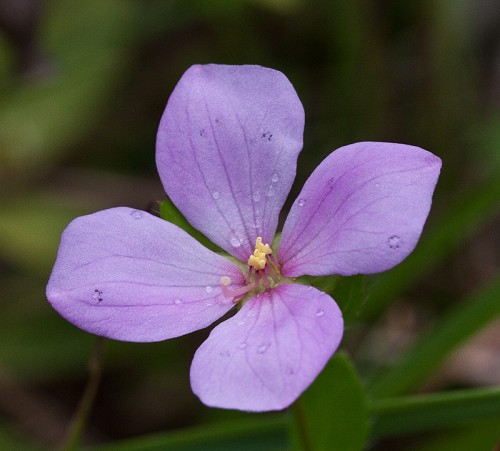Difference between revisions of "Rhexia petiolata"
| Line 33: | Line 33: | ||
===Habitat=== <!--Natural communities, human disturbed habitats, topography, hydrology, soils, light, fire regime requirements for removal of competition, etc.--> | ===Habitat=== <!--Natural communities, human disturbed habitats, topography, hydrology, soils, light, fire regime requirements for removal of competition, etc.--> | ||
| − | ''R. petiolata'' proliferates in wet pine flatwoods and savannas, pocosin borders, cypress ponds and swamps, slope bogs, marshes, longleaf pine forests, and ditches.<ref name= "Weakley 2015"> Weakley, A. S. (2015). Flora of the Southern and Mid-Atlantic States. Chapel Hill, NC, University of North Carolina Herbarium.</ref><ref name="FSU"> Florida State University Herbarium Database. URL: http://herbarium.bio.fsu.edu. Last accessed: June 2021. Collectors: Loran C. Anderson and R. Kral. States and counties: Florida: Bay, Clay, Franklin, Lee, Levy, and Osceola. Georgia: Thomas.</ref> It is also found in disturbed areas including powerline corridors and burned slash pine woods.<ref name="FSU"/> Associated species: ''Rhynchospora, R. nuttallii, Kalmia hirsuta, Ludwigia, Polygala'', and ''Xyris''.<ref name="FSU"/> | + | ''R. petiolata'' proliferates in wet pine flatwoods and savannas, pocosin borders, cypress ponds and swamps, slope bogs, marshes, longleaf pine forests, and ditches.<ref name= "Weakley 2015"> Weakley, A. S. (2015). Flora of the Southern and Mid-Atlantic States. Chapel Hill, NC, University of North Carolina Herbarium.</ref><ref name="FSU"> Florida State University Herbarium Database. URL: http://herbarium.bio.fsu.edu. Last accessed: June 2021. Collectors: Loran C. Anderson and R. Kral. States and counties: Florida: Bay, Clay, Franklin, Lee, Levy, and Osceola. Georgia: Thomas.</ref> It is also found in disturbed areas including powerline corridors and burned slash pine woods.<ref name="FSU"/> |
| + | |||
| + | Associated species: ''Rhynchospora, R. nuttallii, Kalmia hirsuta, Ludwigia, Polygala'', and ''Xyris''.<ref name="FSU"/> | ||
| + | |||
''R. petiolata'' responds positively to soil disturbance by heavy silvilculture in North Carolina.<ref>Cohen, S., R. Braham, and F. Sanchez. (2004). Seed Bank Viability in Disturbed Longleaf Pine Sites. Restoration Ecology 12(4):503-515.</ref> It does not respond to soil disturbance by clearcutting and chopping in North Florida flatwoods forests.<ref>Moore, W.H., B.F. Swindel, and W.S. Terry. (1982). Vegetative Response to Clearcutting and Chopping in a North Florida Flatwoods Forest. Journal of Range Management 35(2):214-218.</ref> | ''R. petiolata'' responds positively to soil disturbance by heavy silvilculture in North Carolina.<ref>Cohen, S., R. Braham, and F. Sanchez. (2004). Seed Bank Viability in Disturbed Longleaf Pine Sites. Restoration Ecology 12(4):503-515.</ref> It does not respond to soil disturbance by clearcutting and chopping in North Florida flatwoods forests.<ref>Moore, W.H., B.F. Swindel, and W.S. Terry. (1982). Vegetative Response to Clearcutting and Chopping in a North Florida Flatwoods Forest. Journal of Range Management 35(2):214-218.</ref> | ||
Revision as of 15:07, 21 June 2021
Common name: ciliate meadow-beauty [1], short-stemmed meadow-beauty [1], fringed meadowbeauty [2]
| Rhexia petiolata | |
|---|---|

| |
| Photo by John Gwaltney hosted at Southeastern Flora.com | |
| Scientific classification | |
| Kingdom: | Plantae |
| Division: | Magnoliophyta - Flowering plants |
| Class: | Magnoliopsida - Dicots |
| Order: | Myrtales |
| Family: | Melastomataceae |
| Genus: | Rhexia |
| Species: | R. petiolata |
| Binomial name | |
| Rhexia petiolatas Walter | |

| |
| Natural range of Rhexia petiolata from USDA NRCS Plants Database. | |
Contents
Taxonomic Notes
Synonyms: R. ciliosa Michaux
Varieties: none
Description
R. petiolata is a perennial forb/herb of the Melastomataceae family native to North America.[2]
Distribution
R. petiolata is found along the southeastern coast of the United States from Texas to Maryland.[2]
Ecology
Habitat
R. petiolata proliferates in wet pine flatwoods and savannas, pocosin borders, cypress ponds and swamps, slope bogs, marshes, longleaf pine forests, and ditches.[1][3] It is also found in disturbed areas including powerline corridors and burned slash pine woods.[3]
Associated species: Rhynchospora, R. nuttallii, Kalmia hirsuta, Ludwigia, Polygala, and Xyris.[3]
R. petiolata responds positively to soil disturbance by heavy silvilculture in North Carolina.[4] It does not respond to soil disturbance by clearcutting and chopping in North Florida flatwoods forests.[5]
Rhexia petiolata is an indicator species for the Panhandle Seepage Savannas community type as described in Carr et al. (2010).[6]
Phenology
R. petiolata has been observed to flower June through October.[7]
Conservation, cultivation, and restoration
Cultural use
It is possible the greens and tubers can be used in salads for a sweetish, nutty taste.[8]
Photo Gallery
References and notes
- ↑ 1.0 1.1 1.2 Weakley, A. S. (2015). Flora of the Southern and Mid-Atlantic States. Chapel Hill, NC, University of North Carolina Herbarium.
- ↑ 2.0 2.1 2.2 USDA Plant Database https://plants.usda.gov/core/profile?symbol=RHPE
- ↑ 3.0 3.1 3.2 Florida State University Herbarium Database. URL: http://herbarium.bio.fsu.edu. Last accessed: June 2021. Collectors: Loran C. Anderson and R. Kral. States and counties: Florida: Bay, Clay, Franklin, Lee, Levy, and Osceola. Georgia: Thomas.
- ↑ Cohen, S., R. Braham, and F. Sanchez. (2004). Seed Bank Viability in Disturbed Longleaf Pine Sites. Restoration Ecology 12(4):503-515.
- ↑ Moore, W.H., B.F. Swindel, and W.S. Terry. (1982). Vegetative Response to Clearcutting and Chopping in a North Florida Flatwoods Forest. Journal of Range Management 35(2):214-218.
- ↑ Carr, S.C., K.M. Robertson, and R.K. Peet. 2010. A vegetation classification of fire-dependent pinelands of Florida. Castanea 75:153-189.
- ↑ Nelson, G. PanFlora: Plant data for the eastern United States with emphasis on the Southeastern Coastal Plains, Florida, and the Florida Panhandle. www.gilnelson.com/PanFlora/ Accessed: 29 MAY 2018
- ↑ Fernald, et al. 1958. Edible Plants of Eastern North America. Harper and Row Publishers, New York.